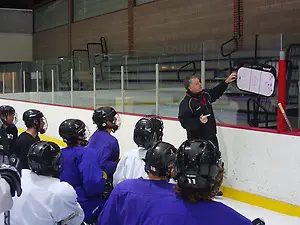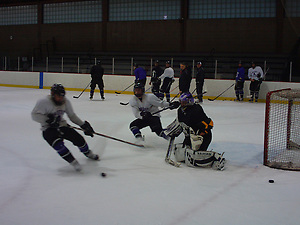Now let’s see: What’s that old expression? “If it ain’t broke, don’t fix it.”
For NESCAC’s number one seed Amherst Lord Jeffs, it really doesn’t seem like anything is “broke” on their 20-3-1 record heading into this weekend’s quarterfinal matchup with Hamilton at home. The fact is they really haven’t changed much all season with their schemes, and their success in the post-season will come down to their excellence in execution as I discovered at their first practice of the week yesterday at Orr Rink.
“We have a couple of different forechecks, breakouts, penalty kills and power plays,” said coach Jack Arena. “We really haven’t used a lot of different things this year at all. There have been times when things on the ice have not been going great and we have discussed changing things up, but at the end of the day, this group has always figured it out and made things work.”
So just what was the focus of an hour-long session Tuesday? First and foremost, it was Arena opening the practice by telling his players to take care of themselves both health-wise and book-wise. It’s never far from the surface in terms of the need to be healthy and stay on top of the demanding academics while trying to play a college sport. Arena brought it out right up front following their Monday off day, and then it was off to some skills work for 10 minutes that got the feet moving and pucks flying up and down the ice. Then practice moved to a lot of situational drills that focused on transition to offense and moving the puck quickly in restricted space.
Want to make a traditional three-on-two more interesting? Divide the ice down the middle in the neutral zone so the whole transition takes place on just one side of the rink entering the offensive zone. Why play in such tight quarters on purpose?
“We know that Hamilton likes to crowd things in the middle,” said assistant coach Gregg DiNardo.”This drill opens up once we get in the zone and forces the play in the middle where you have to use speed and quick decisions with the puck to create offensive chances. At this point in the season, we have seen them twice and vice-versa, so we know what we like to do respectively. Now it is really about executing our game plan successfully with the awareness of their tendencies and how we may be able to take advantage in certain situations, or with particular personnel.”
One area requiring scheme and particular personnel is special teams. Amherst again chooses to keep things simple in its approach to both defending and attacking when a man down or on the power play. During simultaneous sessions at either end of the ice, work was done on both the penalty kill and at the other end, the power play, with a specific focus on options that may best suit attacking Hamilton’s scheme.

During the power play session run by Arena, the puck was worked around quickly and systematically to create one of three grade A scoring opportunities based on openings in the penalty kill system. At several points, the power play was committed to creating a specific opportunity, and the repetition to execute the exact play was run over and over again, demonstrating successful outcomes with the puck in the back of the net. Humor usually came into play here as well. When a puck didn’t get buried on a perfect set-up, Arena would get the players going by saying he needed to move a particular player off that spot since he couldn’t find the back of the net. Point made, laughs had all around, but more importantly there was a clear understanding of the importance of execution — nothing like a little reinforcement entering the “second season.”
Down the other end of the ice, assistant coach Mike McLaughlin was taking the penalty-kill unit through a simulation of the Hamilton power play. After a whiteboard session defining key attacking players and roles, the team took to the ice for a spirited kill session where the only thing missing was the actual numbers on the jerseys for the Hamilton players on the power play.
“We have seen them twice now, most recently in mid-January,” said McLaughlin. “We also spend a fair amount of time with film, so there are particular things we will focus on, making sure we have the right coverage and awareness, particularly with their first line. DiMare and Scarpino are very good hockey players. They are quick, slippery, and talented offensive players, so we need to make sure we do a good job in our defensive end, not only on special teams, but even-strength as well.”

Some additional neutral ice drills were also run through, with a focus on the breakout and offensive transition. One neat coaching trick I garnered here was the movement of the nets to the top of the circles and the constant positioning of one defenseman behind his blue line. The three-on-three, four-on-four, and five-on-five drills forced quick transition through neutral ice with sharp cuts and quick accelerations by forwards seeking to shed trapping defenders and create good passing lanes for the puck coming from the defensive zone. After all of the hard skating and simulated game play, the snow had already accumulated to Snow Cone proportions on the ice, mandating that every pass and every shot be hard and crisp to get to its appointed destination on the tape of a teammate.
A second whiteboard session for the team at center ice talked about the breakout and transition through the neutral zone. That was followed by more game-like simulations of the same before the coaches’ challenge and whether or not there would be any skating or conditioning work to wrap-up the session. Through the accumulated snow, DiNardo took an end-to-end shot that missed the net, wide left. No goal, no sprints. A small cheer was let out by the group, but you just knew that had the puck gone in they would have skated and still been smiling, just like the rest of practice.
“We actually went a little longer today than we wanted to,” said Arena. “Last Tuesday, we skated them very hard, so in the back of their minds they might have been wondering about this week. At this point in the season, rest is more important than anything else. We really want to only be skating for about 50 minutes at this point in the year. These kids are conditioned, and now we need to make sure they are healthy and rested for the one game this weekend. That is what the focus is. We will do a quick film session upstairs for about a half hour and then cut them loose with another off day tomorrow.”
As the Amherst women’s team prepared to take the ice in preparation for their conference tournament, a quick change act by all the players and coaches led to the film session in the hockey offices and finally, for the players, back to campus for food and studies.
While this practice was specific to Amherst’s preparation, everyone in the conference playoffs is focused on the same things this week: Trying to keep things normal, resting the players a bit more than during the regular season, and fine-tuning the game for the quarterfinals this weekend. The methods may be different, but the overriding themes are the same — be ready to bring the “A” game on Saturday.
This weekend, its win or go home — drop the puck!
Special thanks to all of the Amherst coaches and players for their great hospitality on and off the ice and for educating this writer on the finer points of game preparation and at every level keeping it fun for the players.


